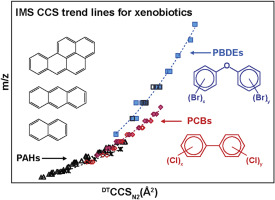当前位置:
X-MOL 学术
›
Anal. Chim. Acta
›
论文详情
Our official English website, www.x-mol.net, welcomes your
feedback! (Note: you will need to create a separate account there.)
Utilizing ion mobility spectrometry and mass spectrometry for the analysis of polycyclic aromatic hydrocarbons, polychlorinated biphenyls, polybrominated diphenyl ethers and their metabolites
Analytica Chimica Acta ( IF 5.7 ) Pub Date : 2018-12-01 , DOI: 10.1016/j.aca.2018.02.054 Xueyun Zheng , Kevin T. Dupuis , Noor A. Aly , Yuxuan Zhou , Francesca B. Smith , Keqi Tang , Richard D. Smith , Erin S. Baker
Analytica Chimica Acta ( IF 5.7 ) Pub Date : 2018-12-01 , DOI: 10.1016/j.aca.2018.02.054 Xueyun Zheng , Kevin T. Dupuis , Noor A. Aly , Yuxuan Zhou , Francesca B. Smith , Keqi Tang , Richard D. Smith , Erin S. Baker

|
Polycyclic aromatic hydrocarbons (PAHs), polychlorinated biphenyls (PCBs) and polybrominated diphenyl ethers (PBDEs) are persistent environmental pollutants originating from incomplete combustion of organic materials and synthetic sources. PAHs, PCBs, and PBDEs have all been shown to have a significant effect on human health with correlations to cancer and other diseases. Therefore, measuring the presence of these xenobiotics in the environment and human body is imperative for assessing their health risks. To date, their analyses require both gas chromatography and liquid chromatography separations in conjunction with mass spectrometry measurements for detection of both the parent molecules and their hydroxylated metabolites, making their studies extremely time consuming. In this work, we characterized PAHs, PCBs, PBDEs and their hydroxylated metabolites using ion mobility spectrometry coupled with mass spectrometry (IMS-MS) and in combination with different ionization methods including electrospray ionization (ESI), atmospheric pressure chemical ionization (APCI) and atmospheric pressure photoionization (APPI). The collision cross section and m/z trend lines derived from the IMS-MS analyses displayed distinct trends for each molecule type. Additionally, the rapid isomeric and molecular separations possible with IMS-MS showed great promise for quickly distinguishing the parent and metabolized PAH, PCB, and PDBE molecules in complex environmental and biological samples.
中文翻译:

利用离子迁移谱和质谱分析多环芳烃、多氯联苯、多溴二苯醚及其代谢物
多环芳烃 (PAH)、多氯联苯 (PCB) 和多溴联苯醚 (PBDE) 是源自有机材料和合成来源的不完全燃烧的持久性环境污染物。PAHs、PCBs 和 PBDEs 都已被证明对人类健康有显着影响,并且与癌症和其他疾病相关。因此,测量环境和人体中这些异生素的存在对于评估它们的健康风险是必不可少的。迄今为止,他们的分析需要气相色谱和液相色谱分离并结合质谱测量来检测母体分子及其羟基化代谢物,这使得他们的研究非常耗时。在这项工作中,我们表征了多环芳烃、多氯联苯、使用离子迁移谱与质谱联用 (IMS-MS) 并结合不同的电离方法,包括电喷雾电离 (ESI)、大气压化学电离 (APCI) 和大气压光电离 (APPI),多溴二苯醚及其羟基化代谢物。来自 IMS-MS 分析的碰撞截面和 m/z 趋势线显示了每种分子类型的不同趋势。此外,IMS-MS 可实现的快速异构和分子分离显示出在复杂环境和生物样品中快速区分母体和代谢的 PAH、PCB 和 PDBE 分子的巨大希望。大气压化学电离 (APCI) 和大气压光电离 (APPI)。来自 IMS-MS 分析的碰撞截面和 m/z 趋势线显示了每种分子类型的不同趋势。此外,IMS-MS 可实现的快速异构和分子分离显示出在复杂环境和生物样品中快速区分母体和代谢的 PAH、PCB 和 PDBE 分子的巨大希望。大气压化学电离 (APCI) 和大气压光电离 (APPI)。来自 IMS-MS 分析的碰撞截面和 m/z 趋势线显示了每种分子类型的不同趋势。此外,IMS-MS 可实现的快速异构和分子分离显示出在复杂环境和生物样品中快速区分母体和代谢的 PAH、PCB 和 PDBE 分子的巨大希望。
更新日期:2018-12-01
中文翻译:

利用离子迁移谱和质谱分析多环芳烃、多氯联苯、多溴二苯醚及其代谢物
多环芳烃 (PAH)、多氯联苯 (PCB) 和多溴联苯醚 (PBDE) 是源自有机材料和合成来源的不完全燃烧的持久性环境污染物。PAHs、PCBs 和 PBDEs 都已被证明对人类健康有显着影响,并且与癌症和其他疾病相关。因此,测量环境和人体中这些异生素的存在对于评估它们的健康风险是必不可少的。迄今为止,他们的分析需要气相色谱和液相色谱分离并结合质谱测量来检测母体分子及其羟基化代谢物,这使得他们的研究非常耗时。在这项工作中,我们表征了多环芳烃、多氯联苯、使用离子迁移谱与质谱联用 (IMS-MS) 并结合不同的电离方法,包括电喷雾电离 (ESI)、大气压化学电离 (APCI) 和大气压光电离 (APPI),多溴二苯醚及其羟基化代谢物。来自 IMS-MS 分析的碰撞截面和 m/z 趋势线显示了每种分子类型的不同趋势。此外,IMS-MS 可实现的快速异构和分子分离显示出在复杂环境和生物样品中快速区分母体和代谢的 PAH、PCB 和 PDBE 分子的巨大希望。大气压化学电离 (APCI) 和大气压光电离 (APPI)。来自 IMS-MS 分析的碰撞截面和 m/z 趋势线显示了每种分子类型的不同趋势。此外,IMS-MS 可实现的快速异构和分子分离显示出在复杂环境和生物样品中快速区分母体和代谢的 PAH、PCB 和 PDBE 分子的巨大希望。大气压化学电离 (APCI) 和大气压光电离 (APPI)。来自 IMS-MS 分析的碰撞截面和 m/z 趋势线显示了每种分子类型的不同趋势。此外,IMS-MS 可实现的快速异构和分子分离显示出在复杂环境和生物样品中快速区分母体和代谢的 PAH、PCB 和 PDBE 分子的巨大希望。











































 京公网安备 11010802027423号
京公网安备 11010802027423号